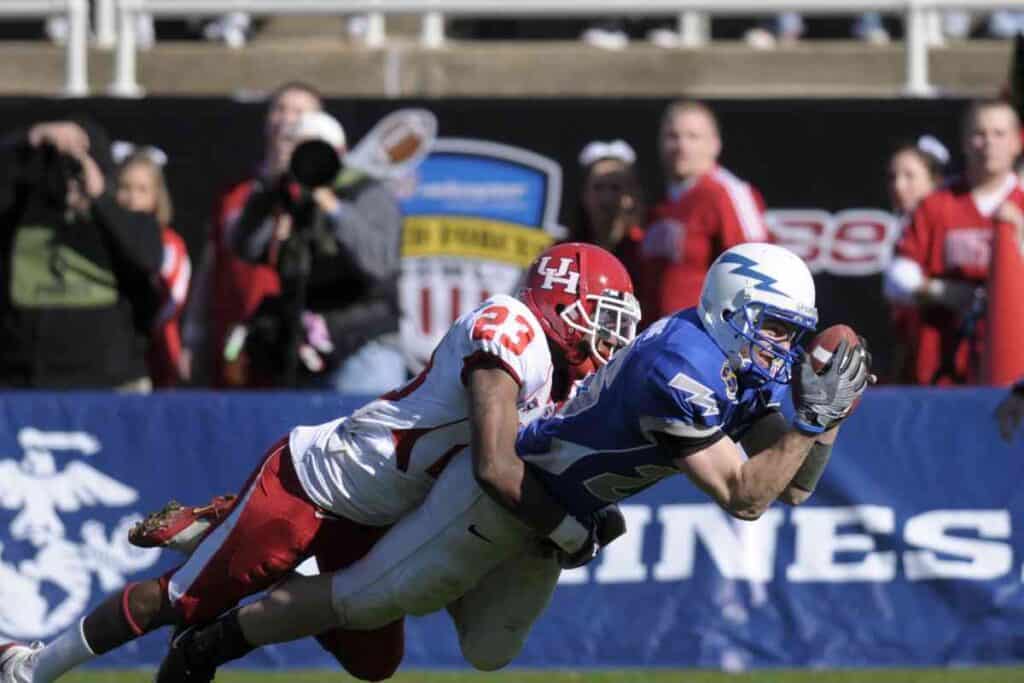Are There Age Limits In College Football?
You are a college student who started late and loves to play football, but are you too old to make the team? How old can you be to join college football?

How old is too old to join a college football team?
The NCAA has no age limit on participation in collegiate sports, but there are very stringent eligibility requirements about who can play. Once you enroll in an educational institution, the timer clock begins, and you have five years to complete four seasons of play.
The growth of college football means that more players than ever are interested in participating.
And while some older players suit up just to prove to themselves they can still run with the kids, others participate out of love for the game. While football might be considered a young man’s game played by men in their early twenties, players much older continue to follow their dreams of gridiron glory.
But how old can you be to play college football? Does the NCAA have eligibility rules about who can play and when? What about academic requirements? If you enroll as a full-time student, what should you know before you strap on the pads and walk out onto the field? This article will answer your college athletic questions to help you make the best decision for your playing career.
What Are the NCAA Guidelines For Age?
The NCAA (National Collegiate Athletic Association) has no guidelines regarding how old a person can be to play collegiate athletics.
However, there are strict eligibility requirements for number of seasons an individual can play, and these rules vary depending on the accredited division a college or university has been given.
Division 1 Programs

In a Division 1 school, participants in college sports have five calendar years to play four seasons of football once they enroll as full-time students.
The ramifications of this time clock are significant because it means that no matter when you might have graduated high school, as long as you have not enrolled in college anywhere as a full-time student, you have five eligible years.
The timer clock starts the first day of classes of the school year and runs straight through regardless of whether you are enrolled.
If you take a break, the clock does not stop, except for some specific situations, like military service. The same regulations apply to athletes of other sports, like track and field or cross country.
All players must graduate high school or an accredited school, having completed 16 core courses during that time, including four years of English, three years of Math, two years of Social studies and Science, and four years of elective classes.
These classes college football players take must have been finished before graduating high school (most schools have the same or similar requirements for graduates to meet state educational standards).
Players must also maintain a minimum 2.3 GPA (grade point average) throughout high school with a 980 SAT combined score or a 75 ACT sum score.
In addition, all participants must qualify as an amateur by NCAA guidelines. (Basically, they cannot have participated in the sport for money or competed on a professional or semi-professional team).
While not every class will qualify as one of the NCAA’s Sweet Sixteen core courses, most of them do. Counselors know the eligibility rules and are always at the disposal of student-athletes to help guide and direct them to success as they seek to play college sports.

Division 2 Programs
The requirements for college sports eligibility for a Division II school are very similar to their Div. 1 counterparts
The requirement is a high school diploma, and students have taken the 16 core courses (4 years of English, 3 years of Math, 2 years of Science/Social Studies, and 4 years of Electives). Players must maintain a 2.2 GPA with a 900 SAT combined score or a 68 ACT sum score.
Division 3 Programs
Division III schools are mostly smaller private colleges with an average enrollment of around 2,500 students. (Roughly 40% of athletes attend a Div. III institution). There are no eligibility requirements for Div. III schools other than the student-athlete must make satisfactory progress toward a degree.
As long as you have the talent, and can impress the coaches, chances are you will make the football team.
Junior College Programs
The only requirement to participate on a juco football team is for the student athlete to have participated in a high school graduation or have a GED or state-approved equivalent.
They must also qualify as an amateur without having received any kind of remuneration for playing on a pro or semi-pro teach. While the NCAA enforces strict rules, JUCOs have different oversight.
What Is Redshirting and How Does It Affect Eligibility?

Redshirting is designed to allow for an extra year of eligibility for first-year college athletes who need a year to mature and develop in the eyes of the coaches.
These student-athletes are allowed to practice, attend team meetings, and consult with coaches but are not allowed to play.
There are two primary ways an athlete might redshirt and extend the clock of their ability to play in their college career.
Voluntary Redshirting
Occasionally, coaches feel that athletes need more maturity or know there is just no chance of a player having an opportunity to compete. Instead of wasting a year of eligibility, the coach may ask the player (or the player might request) to spend the upcoming year as a voluntary redshirt.
This designation means that the athlete can still receive a scholarship, attend classes, and practice with the team, but they cannot compete.
The player is not allowed to travel with the team during the regular season but can participate in any other sanctioned team activities except for playing in competitions or exhibitions.
Medical Reshirting
At times, football can be a violent sport, which means that often guys battle injuries.
A medical redshirt is granted by the NCAA when requested should a player not be able to compete due to illness or injury that hinders their ability to play.
The injury must have occurred in the first half of the season. The player has played in no more than four games or 30% of the season (whichever is greater).
What Is A Military Exemption?
The NCAA will extend the five-year eligibility rule by one year for students called to serve in military service. The clock stops while the athlete is serving in the armed forces and restarts the moment that they re-enroll.
At no time can a student receive a military exemption while serving and playing at the same time. (You must stop the clock and serve, or don’t serve in the military and play).
Can The NCAA Extend Eligibility for Religious Reasons?
Yes, the NCAA has guidelines for players who are required to attend and participate in official church mission programs. Some individuals are required to serve to complete their religious education.
There is no exemption for volunteering in the Peace Corps or other non-profit organizations as these rely on volunteer staff rather than forcing individuals to serve to fulfill religious obligations.
Who Is The Oldest Player To Play College Football?
Several players have laced up the pads in their forties, fifties, even in their sixties. Here are a few examples of players who have bucked the idea that younger men should play football.
Tom Thompson, a placekicker who played for Austin College in Sherman, Texas, is the oldest player to play college football. On November 14, 2009, at the age of 61, Thompson entered the game and kicked the extra point for the team’s only touchdown against Trinity College.
Joe Thomas Sr. is the oldest player to have played in Div. I college football, when at age 55, he came into the game of South Carolina State, took a handoff, and gained three yards.
In what had been a lifelong dream, Thomas enrolled in the university at the same time as his son, Joe Thomas, Jr. Both players made the team, and while the junior Joe Thomas went on to play in the NFL, the accomplishment of his father made a moment of NCAA history.
The oldest current active player is Tom Hutton, a punter for Oklahoma State who enrolled in classes in 2022 at 29. It would not be long before he made the team and is presently on the Cowboy’s roster.
Since college football is a young man’s game (most players are under 24 years of age), the physical demands on a player’s body can be taxing the older a person becomes.
Most post twenty-five-year-old athletes turn to coaching for reffing college sports in some form or another to continue their football careers.
Recommended Reading
- NCAA Vs. NFL: Is College Or Professional Football Bigger?
- Can you play high school football at 18
- How many high school football players go D1?
- Can college football players drink alcohol?
- Are college football tickets free for students?
- Here’s how many years you can play High School football!
- Does college football have a 2 minute warning
- Why do college football players wear short pants?
Key Takeaways
- There are no age requirements relating to who can play college football.
- All student-athletes have five years to complete four seasons of football.
- The five-year clock begins the moment a student enrolls and begins coursework.
